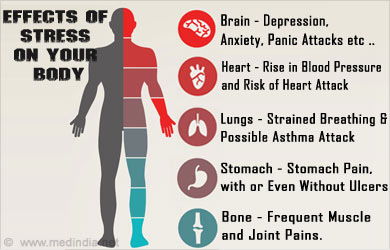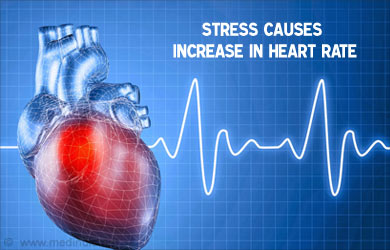Yoga is an alternative system of healing, its power being widely harnessed to prevent and treat various diseases of the heart. Yoga is undoubtedly a reliable avenue for holistic health.
Disease is a manifestation of underlying disharmony in the mind- body domain. Yogic way of life offers a solution to elevate the health of body, mind and soul. Yoga is a cure for many diseases - diabetes, obesity and psychiatric illnesses - as much as it offers immense benefits to alleviate heart diseases.
Yoga has an important role in the prevention of cardiovascular diseases that includes recurrence of heart attacks, hypertension and coronary heart diseases. Yoga influences the hypothalamus directly, the area of the brain that controls endocrine activity, and helps prevent heart attacks.
A complete yoga program involves exercises (asanas),breath control(pranayama), sleep control(yoga Nidra) and mind control(meditation).These are the tenets for cardiac health; also probably the reason why cardiologists universally, recommend yoga to their patients. The curative benefits of yoga enhances heart health, lowers blood pressure, reduces chronic stress, boosts the immune system and enhances cognitive ability.
Heart of the Matter
Heart disease is a problem of modern times. It is psychosomatic in nature. Improper lifestyle, faulty diet and negative thinking play an important part in triggering heart disease. Our thoughts, feelings and emotions affect our body and mind. Negative emotions spark chemical processes throughout the entire body. Any irritation in the lining of arterial walls - which includes high levels of fat in the blood, smoking and high blood pressure- can trigger heart diseases,
Vedic wisdom in yoga lays emphasis on four aspects that have a direct bearing on health. They are:
Achaar (character and conduct): It stands for moral virtues - truthfulness, chastity, compassion and kindness.
Vichaar (perception or the way we think): The way we think influences our way of life. Develop a positive outlook in life and remove negative thoughts from the mind.
Vyayahaar (the way we behave):It pays to replace undesirable habits with positive ones. If we fear change and cling to old, negative habits, we cannot succeed in yoga.
Ahaar (diet or the food we eat): Food sustains our body. What we eat affects our mind directly. Intake of proper and healthy food nourishes body and mind. Avoid over- eating and eat in moderation.
Any imbalance in any of these aspects results in disharmony of body, mind and soul. This paves the way for diseases.
In addition, mental relaxation through meditation and yoga contribute immensely in offsetting arteriosclerosis (coronary artery blocked due to the deposition of fats on the inner walls of the heart). Thus, owing to its many positive effects- direct and indirect on the cardiovascular system, yoga assumes a pivotal role in heart care.
Disease is a manifestation of underlying disharmony in the mind- body domain. Yogic way of life offers a solution to elevate the health of body, mind and soul. Yoga is a cure for many diseases - diabetes, obesity and psychiatric illnesses - as much as it offers immense benefits to alleviate heart diseases.
Yoga has an important role in the prevention of cardiovascular diseases that includes recurrence of heart attacks, hypertension and coronary heart diseases. Yoga influences the hypothalamus directly, the area of the brain that controls endocrine activity, and helps prevent heart attacks.
A complete yoga program involves exercises (asanas),breath control(pranayama), sleep control(yoga Nidra) and mind control(meditation).These are the tenets for cardiac health; also probably the reason why cardiologists universally, recommend yoga to their patients. The curative benefits of yoga enhances heart health, lowers blood pressure, reduces chronic stress, boosts the immune system and enhances cognitive ability.
Heart of the Matter
Heart disease is a problem of modern times. It is psychosomatic in nature. Improper lifestyle, faulty diet and negative thinking play an important part in triggering heart disease. Our thoughts, feelings and emotions affect our body and mind. Negative emotions spark chemical processes throughout the entire body. Any irritation in the lining of arterial walls - which includes high levels of fat in the blood, smoking and high blood pressure- can trigger heart diseases,
Vedic wisdom in yoga lays emphasis on four aspects that have a direct bearing on health. They are:
Achaar (character and conduct): It stands for moral virtues - truthfulness, chastity, compassion and kindness.
Vichaar (perception or the way we think): The way we think influences our way of life. Develop a positive outlook in life and remove negative thoughts from the mind.
Vyayahaar (the way we behave):It pays to replace undesirable habits with positive ones. If we fear change and cling to old, negative habits, we cannot succeed in yoga.
Ahaar (diet or the food we eat): Food sustains our body. What we eat affects our mind directly. Intake of proper and healthy food nourishes body and mind. Avoid over- eating and eat in moderation.
Any imbalance in any of these aspects results in disharmony of body, mind and soul. This paves the way for diseases.
In addition, mental relaxation through meditation and yoga contribute immensely in offsetting arteriosclerosis (coronary artery blocked due to the deposition of fats on the inner walls of the heart). Thus, owing to its many positive effects- direct and indirect on the cardiovascular system, yoga assumes a pivotal role in heart care.











